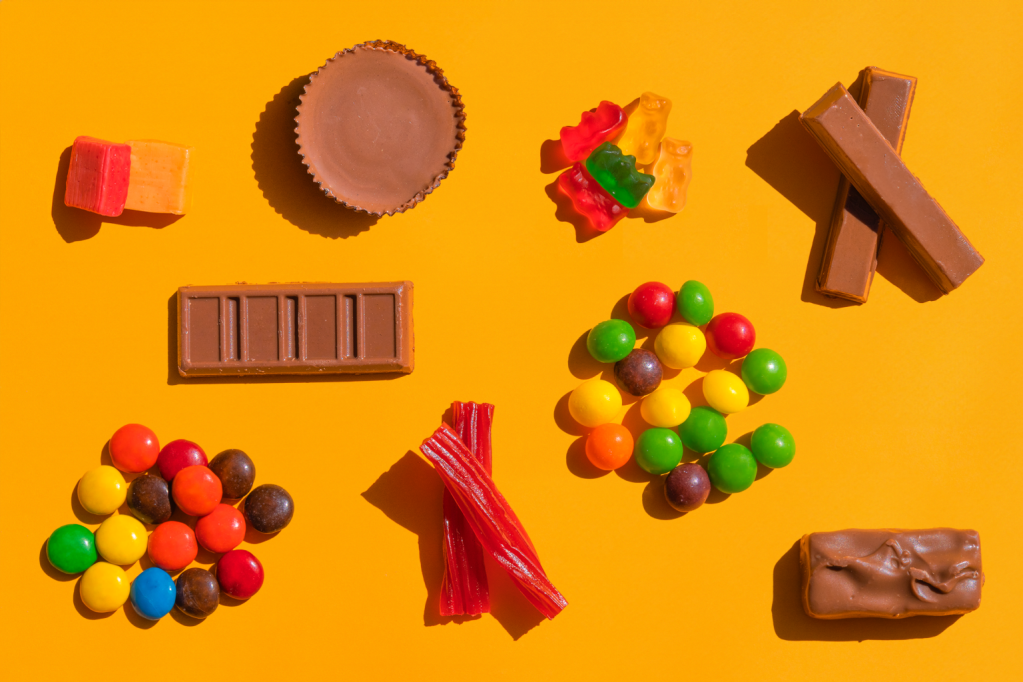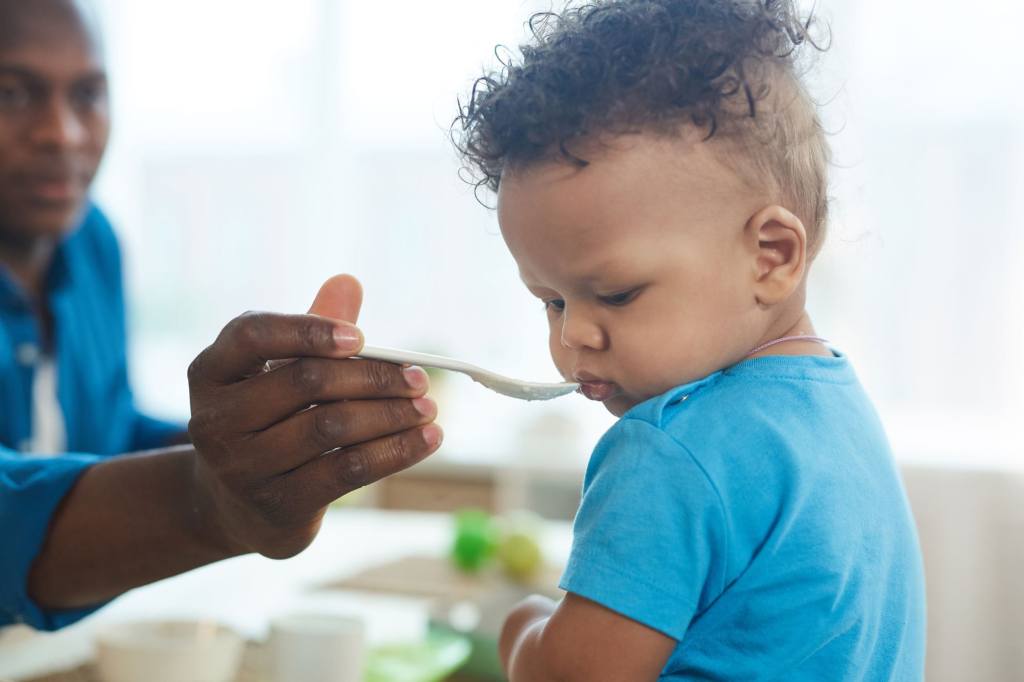Your cart is currently empty!
It’s important to know how much food your baby needs to grow and thrive. Let’s talk about what you need to know about serving portions for 8, 9, 10 month old babies.
Baby Serving Portions: How Much Should my Child Be Eating
How much food should my child be eating?
If you’ve found yourself asking this question or doubting the amount of food you’re feeding your child, don’t worry. We’ve been there too. Nothing is simple when it comes to babies.
They grow at different rates and some babies eat more than others. While there’s no one-size-fits-all guide to parenting or even eating for that matter, there are lots of signs and guides to help you know how much food to give your little one so they can stay healthy.
So how much should your little one be eating at eight, nine or ten months? Here are some of the signs to look for and some helpful tips to guide you along the way!

Serving Size Matters
Serving sizes can be complicated when it comes to babies as each baby is different. However, giving your baby the appropriate portions is vital to growth and development. Giving your baby too much food can result in undesired weight gain, and not giving them enough food can deprive them of vital nutrients and calories their bodies need to grow!
Serving sizes also change as your baby grows. Three of the most vital ages of this growth are months eight, nine, or ten. Let’s break down how much your baby should be eating during these times.

8 Month Baby Food
When your baby turns 8 months, their brains and bodies are busy growing. They are making important brain-body connections and learning how their movements interact with the world. Their brains are also learning language skills and how to communicate.
With all this going on, they need lots of fuel! But how much?
Breastmilk
Your baby will still be relying on breastmilk or formula to provide nutrients and hydration as they’re eating solid foods. Of course, the amount of breast milk you give them depends on how much solid food they eat.
According to Stanford Children’s Health, your little one should still be consuming anywhere from three to five feedings of breastmilk or formula per day. This adds up to around 30 to 32 ounces per day. This may seem like a lot of breastmilk, but your baby’s belly has grown significantly and is able to hold more than when they were five months old.
Solid Foods
In addition to breastmilk or formula feedings each day, your little one will be eating lots of solid food. At this point, they will be trying all sorts of new flavors and combinations which will help develop their taste and texture palettes and make them less picky in the future.
How Much Solid Food?
Your 8-month-old baby will probably be eating around three jars of food per day along with one or two snacks and breast feedings. Each jar of baby food is around 118 mL (4 ounces), so the total amount of solid food your little one needs is around 12 ounces plus two snacks!
What Kinds of Baby Food?
The key nutrients your little one needs at this age are magnesium, fiber, folate, and omega-3s.
Magnesium helps with your baby’s sleep and brain development. This nutrient can be found in pumpkin, potatoes, beans, spinach, fish, broccoli, apples, and carrots. Fibers can be found in our Stage 3 Duos and Stage 4 Mashable baby foods. Folate is important for DNA synthesis and can be found in spinach, green peas, tomatoes, papaya, cantaloupe, beans, and avocado.
Lastly, omega-3s are vital for protein synthesis, energy, heart health, and immune health. Sources of omega-3s include flaxseeds, canola oils, plant oils, and fish. By giving your little one lots of variety, you can be sure to provide a wide range of nutrients to meet their needs.
Learn more about 8 month baby food here.

9 Month Baby Food
When your little one turns 9 months, they start moving! They may crawl on their tummies or move back and forth, so while you’re keeping up with your little crawler, you also have to keep up with their calorie and nutritional needs.
Breastmilk
Your baby’s breast milk needs during this time actually stay the same! You can give them anywhere from 30 to 32 ounces of breastmilk or formula to provide them with nutrients and hydration they need. If your little one doesn’t seem to want the full 30 ounces of breastmilk, it’s okay to give them less milk and more solid food.
Solid Foods
As far as solid foods go, your little one will still be eating around three meals a day with a few snacks. This adds up to 12 ounces of solid foods per day plus their two snacks. This food will also be thicker and more textured than what they were eating at 8 months.
What Kinds of Baby Food?
Your baby’s food should always contain nutrients that fuel their developmental milestones. At nine months, your little one needs copper, magnesium, manganese, calcium, and protein for growth, metabolism, movement, strength, and brain development. Look for foods with fibers, skins, and chia seeds.

10 Month Baby Food
When your babe turns 10 months, they will be learning to grab things with their hands, moving objects around, standing and playing and so much more. Your babe’s portion sizes change a bit during this time too, so let’s talk about it.
Breastmilk
At ten months, your baby’s reliance on breast milk decreases. You can offer your babe anywhere from 24 to 30 ounces of breast milk or formula per day. This adds up to three or four feedings per day but be sure to listen to your baby’s hunger cues if you aren’t sure how much breast milk they need.
Solid Foods
One main difference in what your little one will eat at 10 months involves their snacks. They will likely eat more finger foods and be interested in what you’re eating. Stick with the same amount of solid foods (12 ounces or three jars) but listen to your baby’s hunger cues. They may finish all of their food and want some more, or they may eat a little less than this.
What Kinds of Baby Food?
At this time, your baby relies on calcium and protein to strengthen their bones and promote movement and growth. Luckily, calcium is not just found in dairy products. You can find calcium in kale, broccoli. cabbage, fish, and quinoa.

Know Your Baby’s Cues
One of the most important things to keep in mind when feeding your baby and learning how much food they need is their cues. Your baby has hunger cues to tell you what they want. If they’re still hungry and need more food, they’ll let you know.
Here are some of the hunger cues to look for:
Know When They Want More
Here are some signs that your baby wants more food. They might put their hands in their mouth or put objects in their mouth, they may open their mouth when mom’s breast is near or when they see a bottle, they might smack their lips, lick their lips, or pucker, and they may clench their hands in a grabbing motion.
If your baby is doing these things, you can offer some food or breast milk.
Know When They’re Full
If your baby is full, they will let you know. Some of the ways they do this may be by pushing food away. They might push the jar of food away or push the spoon away. Your baby may also keep their mouth shut or turn their head away to indicate that they’re done eating for now.
It’s important to listen to these cues, even if your baby hasn’t finished the jar of food or cleaned their plate.
Trust Your Little One
Your baby doesn’t have to clean their plate. If you expect your child to eat all their food, you may cause more harm than good. Instead, trust their fullness cues and listen to them! This way, you won’t overfeed your baby. If you notice major changes in your baby’s appetite or eating habits, don’t worry. Change is normal. If you do have concerns, don’t hesitate to talk to your pediatrician!
It’s important to avoid underfeeding and overfeeding your baby. For more tips on how to do this, our experts break down what your baby’s diet might look like here.
Summary
Babies can be complicated and taking care of your little one can be a big learning curve. So, it’s a good thing they don’t stop communicating! As you follow the guidelines suggested by baby experts, don’t forget to listen to your baby too. They will let you know how much food they need, so trust them.
Our Yumi Milestone Plan grows and changes along with your baby, providing just the right nutrition every step of the way. Learn more about your baby’s milestone plan here.









